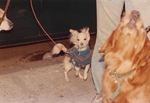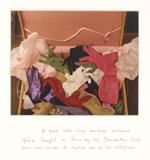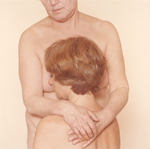Negotiations: Gender and Color Photography
In 1982, a decade after Larry Siegel had organized a two-part exhibition of Women Photographers, Michael Spano showed the work of three women artists. The title of the show (Three Photographers Working in Color) connected the photographers through their use of medium, not their sex. Even though the debate in the 1970s over gender difference and the question of a “female vision” in photography remained largely unresolved, female artists had by this time carved out an evident niche in alternative spaces and associations such as A.I.R. Gallery and Professional Women Photographers. Color photography, on the other hand, was still something of a novelty, as witnessed by the predominance of black-and-white work exhibited during the gallery’s first decade. Institutional acceptance of color photography was a slow process, which began to accelerate only after the solo exhibition of William Eggleston at the Museum of Modern Art in 1976. The following year, the newly opened Space Gallery in New York City specifically promoted photographers who worked in color.
In the early 1980s, critics and curators were still searching for an analytical vocabulary to deal with color photography, much as they had attempted to find ways to describe the work of women in the 1970s. This is reflected in the press material for the 1982 Midtown Y exhibition, where the subject of gender is treated matter-of-factly (and only in the work of Niki Berg), whereas color, the putative theme of the show, is discussed tentatively. Feminism, of course, was still very much a current topic, as illustrated by another 1982 group exhibition, Evelyn Apgar’s Generations, one of 16 shows organized that year by the New York City Chapter of the Women’s Caucus for Art. Like the photographers in that exhibition, both Niki Berg and Linda Hackett might be considered part of what Betty Friedan in 1981 called “second-stage” feminism, which dealt to a certain extent with the tension between independence and the responsibility of domesticity and motherhood.
In 1984, as debates over identity politics were reaching their height, Michael Spano invited the photography dealer Julie Saul to give a “Postmodern Update” at the gallery. Exhibitions at the Midtown Y, however, mostly steered clear of theoretical entanglement, even when the work exhibited touched upon relevant themes.
 Susan Unterberg (b. 1941)
Susan Unterberg (b. 1941)
Untitled, ca. 1982
Chromogenic print
Photographs from Unterberg’s Garden Series were originally included in the 1982 exhibition Three Photographers Working in Color; the photographer donated an image from her series Dogs to the Midtown Y.
 Linda Hackett (b. 1939)
Linda Hackett (b. 1939)
Untitled
Chromogenic print
Included in the exhibition Three Photographers Working in Color, November 4–November 28, 1982
From the exhibition press release dated November 1982:
Linda Hackett has gone back to the house she grew up in on the Upper East Side of Manhattan and photographed her childhood environment. Although she left this house 23 years ago, the rooms are all preserved in their original state. The body of work produced in these spaces is tightly composed and shows a strong awareness of color and light. They result in a wonderful visual echo of times past.
 Niki Berg (b. 1939)
Niki Berg (b. 1939)
Untitled, 1981
Chromogenic print
Included in the exhibition Three Photographers Working in Color, November 4–November 28, 1982
From the exhibition press release dated November 1982:
Niki Berg’s work comprises a series of nude portraits of her mother and her self. Clothing and props were put aside to exclude extraneous detail, thus allowing the photographer to use expression, color, form and movement to evoke the emotions and stages of a mother and daughter relationship. As the series develops it becomes clear that the cycle of nurturing, struggle, growth and separation of two women are the real concerns and universality of these images.
Next Section